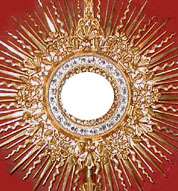Concepción Cabrera de Armida

The Venerable Concepción Cabrera de Armida (born December 8, 1862 in San Luis Potosí, Mexico and died on March 3, 1937 in Mexico City) was a Mexican Roman Catholic mystic and writer.[1][2]
She is also referred to as María Concepción Cabrera Arias de Armida, sometimes as Conchita Cabrera de Armida or Conchita Cabrera Arias de Armida, and often simply as Conchita.
Life
She was born to Octaviano Cabrera Lacaveux and Clara Arias Rivera who had a respectable, but not lavish family life. She had a simple, happy and at times playful childhood. Although she recalled to have often disobeyed her parents as a child, she showed a special love for the Holy Eucharist from an early age.
In 1884 she married Francisco Armida and had nine children between 1885 and 1899. In 1901, when she was 39 years old, her husband died and she had to care for her children, the youngest of whom was two years old. Her life as a widow was not made any easier by the fact that the Mexican Revolution raged from 1910 to 1921 and took the lives of 900,000 of Mexico's population of 15 million. Yet her writings reflect an amazing tranquility, amid the chaos that surrounded her.
As a mystic, she reported that she heard God telling her: "Ask me for a long suffering life and to write a lot... That's your mission on earth". She never claimed direct visions of Jesus and Mary but spoke of Jesus through her prayers and meditations.
Her spiritual life started before the death of her husband. In 1894 she took "spiritual nuptials" and in 1896 wrote in her diary:
In truth, after I touched God and had an imperfect notion of His Being, I wanted to prostrate myself, my forehead and my heart, in the dust and never get up again.
During her life her writings were examined by the Catholic Church in Mexico and even during her pilgrimage to Rome in 1913 where she had an audience with Pope Pius X. In all cases, Church authorities looked favorably on her writings.
Her writings were widely distributed and inspired the establishment of the five apostolates of the "Works of the Cross" in Mexico: Apostolate of the Cross founded in 1895, Congregation of Sisters of the Cross of the Sacred Heart of Jesus founded in 1897, Covenant of Love with the Heart of Jesus founded in 1909, The Priestly Fraternity founded in 1912, and The Congregation of Missionaries of the Holy Spirit founded in 1914. These apostolates continue today.
Writings
Her children report that they hardly ever saw her writing, but her religious writings and meditations total over 60,000 handwritten pages. The length of her religious writings thus approaches that of Saint Thomas Aquinas.
As a lay woman, she often aimed to show her readers how to love the Church. She wrote:
To love the Church is not to criticize her, not to destroy her, not to try to change her essential structures, not to reduce her to humanism, horizontalism and to the simple service of a human liberation. To love the Church is to cooperate with the work of Redemption by the Cross and in this way obtain the grace of the Holy Spirit come to renew the face of this poor earth, conducting it to its consummation in the design of the Father's immense love.
| Part of a series on |
| Eucharistic adoration of the Catholic Church |
|---|
 Solar monstrance of the Eucharist. |
| Papal documents |
| Organisations and events |
| Notable individuals |
| Eucharistic meditators |
|
|
Her book I Am: Eucharistic Meditations on the Gospel, was the results of meditations during Eucharistic adoration. It aims to clarify the words with which Jesus defines Who He is in a variety of statements beginning with the words: "I am".
In Seasons of the Soul she viewed the maturation of spiritual life as an ongoing process through the various seasons until the soul has fulfilled its purpose on earth. It discusses how the Holy Spirit is at work gradually transforming the soul through its seasons in the image and likeness of Jesus.
The book A Mother's Letters reflects the fact that she was not a cloistered mystic but a busy mother with nine children and a widow during a turbulent time in Mexico's political history. The letters provide a glimpse of her warm, human side as she communicates with her family.
Her other books include: To My Priests, Holy Hours, Before the Altar, You Belong to the Church and Irresistibly Drawn to the Eucharist.
Death
Conchita died on March 3, 1937, at the age of 75 and is buried at the Church of San José del Altillo in Mexico City. She had lived a multi-faceted life, being a mother, a widow, a mystic and a writer. Of herself she wrote:
I carry within me three lives, all very strong: family life with its multiple sorrows of a thousand kinds, that is, the life of a mother; the life of the Works of the Cross with all its sorrows and weight, which at times crushes me until I have no strength left; and the life of the spirit or interior life, which is the heaviest of all, with its highs and lows, its tempests and struggles, its light and darkness. Blessed be God for everything!
Veneration
Her canonization process was started in 1959 by the Archbishop of Mexico City, at which time about 200 volumes of her writings were submitted to the Congregation for the Causes of Saints. Pope John Paul II declared her venerable on December 20, 1999 and she is currently in the process of beatification.
See also
Notes
Sources and External links
- Spanish Wikipedia
- Conchita: A Mother's Spiritual Diary
- Works of the Cross
- I Am: Eucharistic Meditations on the Gospel
- Seasons of the Soul
- Video about Cabrera de Armida at Museum House
